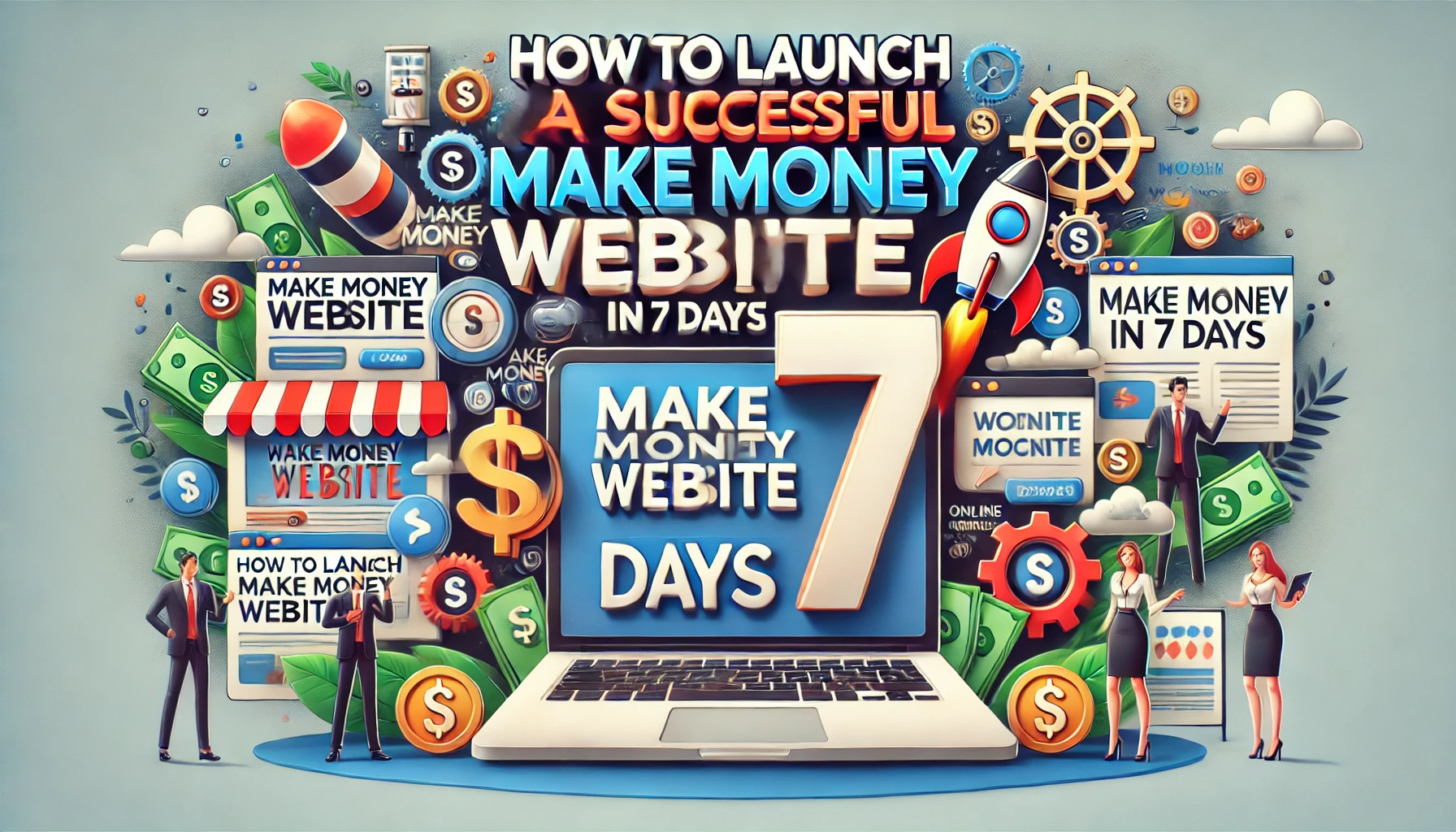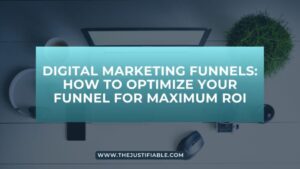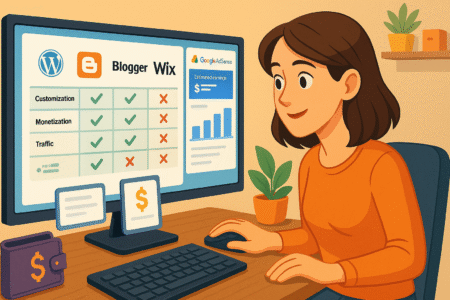Table of Contents
Have you ever wondered how to launch a website that doesn’t just look great but also makes money? If you’ve been dreaming of creating a side income or even a full-time business, starting a make money website could be your golden ticket. But where do you start? How do you choose the right niche? What’s the fastest way to monetize your site?
In this guide, I’ll take you through the exact steps to launch a profitable website in just seven days. Let’s dive in, and by the end of the week, you’ll have a solid foundation ready to generate income.
Day 1: Choose A Profitable Niche For Your Website
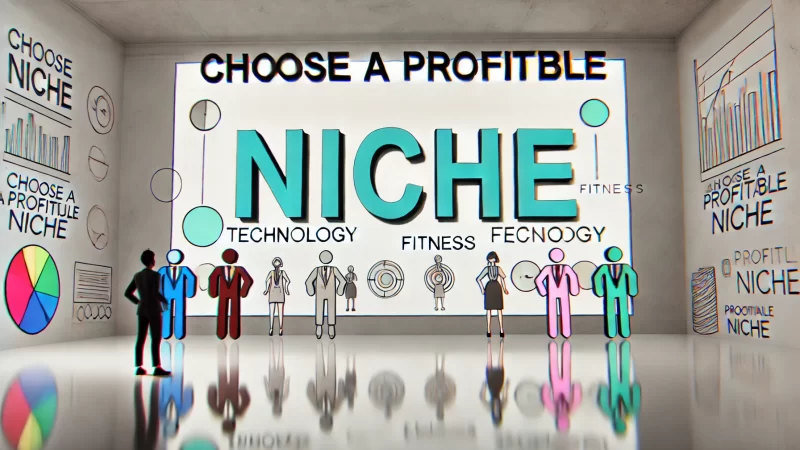
Launching a make money website starts with picking the right niche. Your niche is what will define your audience and determine how profitable your website can be. I suggest choosing a niche that strikes a balance between something you love and something that has high earning potential. This will make content creation easier and more sustainable.
Without a profitable niche, it can be hard to maintain motivation or generate income. Research is key here. Think about niches where people spend money regularly. I advise looking into trending topics, evergreen industries, or areas where you already have some expertise. This will give you a solid foundation to build on.
Understanding What Makes A Niche Profitable
A niche becomes profitable when it has both demand and monetization opportunities. I noticed that niches related to personal finance, health, and technology tend to bring in higher returns. The goal is to find an audience that not only searches for your content but is willing to pay for products or services related to it.
I also recommend looking at the competition within your chosen niche. High competition can mean there’s money to be made, but it also makes it harder to stand out. However, I think you can succeed by offering a unique angle or superior content.
Another aspect I consider is audience engagement. If people are actively seeking solutions in your niche, they’re likely to purchase affiliate products or click on ads. Keep your focus on a niche that solves problems or fulfills needs. That’s where the real profit is.
There’s also a need to gauge the scalability of your niche. Can you grow within it? I feel that niches like lifestyle, tech, or entrepreneurship offer room for long-term growth and multiple revenue streams. Starting small doesn’t mean staying small.
Finally, you must enjoy the niche you choose. I advise this because if you’re not passionate about the topic, you’ll lose steam. A niche you love will keep you motivated to continue creating quality content, which translates into better user engagement and, ultimately, higher income.
How To Research Niches For Earning Potential
When I research a niche, I always start with a combination of keyword research and competitive analysis. Tools like Google Trends can give you a sense of the niche’s popularity over time. I often use keyword tools like Ahrefs or Ubersuggest to find out what people are searching for and how competitive those searches are.
Another method I suggest is diving into forums and social media groups to see what questions people in your niche are asking. This will give you direct insights into what your target audience wants, and you can create content that speaks to their needs. I find this incredibly useful for content planning.
I also advise looking at affiliate programs related to your niche. Can you find products to promote? I think this step is crucial because it helps you confirm whether your chosen niche has monetization potential. Affiliate platforms like ShareASale and Flexoffers are great starting points.
Marketplaces like Etsy, eBay, and even Amazon can also give you hints about niches that generate sales. I find that monitoring what products sell well can inspire ideas for digital products, blog posts, or affiliate recommendations.
Lastly, I recommend exploring niches where you can diversify your income. Think about opportunities like advertising, sponsored content, or digital products. These niches offer more than one way to earn, making your website more stable financially in the long run.
Aligning Your Passion With Profitable Niches
I believe the sweet spot in niche selection lies where passion meets profit. Passion will drive your creativity, while profit ensures sustainability. To align both, list topics that fascinate you. Then, analyze whether they have an audience willing to spend money. This alignment will keep you inspired while also generating revenue.
Next, I suggest reviewing personal experiences. What do you love doing, and where do people turn to you for advice? I think personal stories or expertise make your content relatable and authoritative, both of which can attract readers and turn them into paying customers.
Consider experimenting with a couple of niche ideas before settling on one. I know from experience that exploring several angles can reveal hidden opportunities. Testing different niches with small blog posts or social media content can help you see what resonates most.
It’s also essential to identify a niche that offers future growth. Passion can fade if the niche doesn’t evolve with time. I focus on niches that adapt to trends, like technology or wellness, to ensure my website stays relevant and profitable.
Finally, while profit is essential, I recommend not losing sight of your passion. If you’re in a niche purely for the money, burnout is inevitable. I’ve seen that combining your interests with proven monetization strategies creates long-lasting success for your make money website.
Day 2: Secure A Domain Name And Reliable Hosting Provider

Once you’ve chosen your niche, it’s time to establish your website by securing a domain name and hosting. I believe that choosing the right domain name is crucial because it’s the first thing visitors will see and interact with. It should be memorable, brandable, and reflective of your niche.
The next step is hosting. I recommend using a reliable and secure hosting provider. Your hosting choice can affect your website’s speed, uptime, and security, all of which are vital to creating a good user experience. A fast-loading, secure website not only pleases visitors but also ranks better in search engines.
Choosing A Memorable Domain Name That Reflects Your Niche
Your domain name is your online identity, so I advise making it short, easy to spell, and relevant to your niche. Avoid using numbers or hyphens, as these can confuse visitors. I’ve found that including keywords in your domain can also help with SEO, but it’s more important to make it brandable.
Think of domain names that stick in people’s minds. I suggest brainstorming names that are catchy but also give a clear idea of what your website is about. Tools like Namecheap or GoDaddy offer domain suggestions if you’re stuck on ideas. I find these incredibly helpful.
Remember, your domain name should be easy to type and say aloud. I avoid complicated words or unusual spellings. The easier it is to remember and type, the more likely people are to return to your site. I also recommend checking the availability of social media handles for your domain name.
Once you’ve decided on a name, don’t delay registering it. Good domain names get taken fast, and I’ve seen many people miss out because they waited too long. I suggest registering the domain for at least two years to show search engines your site is here to stay.
Lastly, I advise purchasing the “.com” version of your domain whenever possible. It’s the most recognized and trusted domain extension, making your site appear more professional. If the .com version isn’t available, I think other extensions like .net or .co could work, but .com is still the gold standard.
Selecting A Hosting Provider For Fast And Secure Website Performance
Hosting is the backbone of your make money website, and I’ve learned that a good provider can make all the difference. You want a hosting company that offers fast load times, reliable uptime, and excellent customer support. I suggest using well-known services like Bluehost, SiteGround, or HostGator, especially if you’re new.
Speed is crucial, as visitors will leave if your site takes too long to load. I recommend choosing a hosting provider with solid performance metrics. I’ve found that websites hosted on servers optimized for WordPress generally perform better, so you may want to look for hosts that offer this feature.
Security is another important factor. I always ensure that the hosting provider includes SSL certificates and robust firewalls. These not only protect your site but also improve trust with your audience. A secure website is more likely to rank higher on Google and convert visitors into customers.
Cost is also something to consider. While I advise not cutting corners on hosting, there are affordable options that still offer excellent service. Shared hosting is usually fine for beginners, but I suggest upgrading to VPS or dedicated hosting as your traffic grows.
Lastly, I recommend considering customer service and support options. Hosting issues can happen, and I find it valuable to have access to 24/7 support. Whether through live chat, phone, or email, a good support team can save you a lot of headaches and keep your website running smoothly.
The Importance Of Domain Privacy And Protection
Once you’ve registered your domain, I always recommend adding domain privacy. Without it, your personal information, like your name, address, and phone number, can be publicly available through WHOIS databases. I’ve seen people get bombarded with spam or even phishing attempts because they didn’t protect their information.
Domain privacy replaces your personal details with the registrar’s information, keeping your contact details hidden from the public. I think this is an easy and affordable way to maintain your privacy and avoid unwanted attention.
In addition to privacy, I also advise enabling domain protection services. These protect your domain from accidental expiration or malicious transfers. Losing your domain can be devastating, especially if you’ve built a brand around it. I always double-check that auto-renew is enabled on my domains.
SSL certificates are also critical for domain security. I’ve found that having an SSL certificate not only secures your site but also builds trust with visitors. Most hosting providers offer free SSL certificates, and I suggest enabling them from the start.
Finally, I think it’s a good idea to monitor your domain for any suspicious activity. Some services offer domain monitoring, which alerts you if there are unauthorized changes or transfer attempts. This is especially important if your website becomes valuable over time. Protecting your domain from the start can save you a lot of trouble down the road.
Day 3: Design Your Website With A User-Friendly Theme

Your website’s design is crucial in making a lasting impression on visitors. I suggest choosing a simple, user-friendly theme that is easy to navigate. A clean design not only attracts visitors but also keeps them engaged, reducing bounce rates. Remember, the more comfortable users feel, the more likely they are to stay and explore.
Additionally, I recommend focusing on mobile responsiveness. With most traffic coming from mobile devices, your make money website needs to look great on all screen sizes. Ensure your theme automatically adjusts to different devices, creating a seamless experience that encourages more clicks, conversions, and revenue growth.
Why A Clean And Attractive Design Boosts Conversions
A visually appealing website creates trust instantly. When I browse a site, I am more likely to engage with it if it looks professional and easy to use. Clean designs allow users to find what they need quickly, reducing frustration and encouraging them to take action, like clicking on affiliate links or ads.
I’ve noticed that cluttered designs tend to confuse visitors, leading them to leave before making any decisions. Simplify the design by using plenty of white space, which directs attention to your content or calls to action. I believe this will naturally boost your conversion rates.
Clear, easy-to-read fonts also play a significant role. If your text is hard to read, visitors won’t stay long. I recommend using modern, readable fonts that reflect your brand while enhancing user experience. It’s a small change that has a big impact on conversions.
Don’t forget about color psychology. I’ve learned that colors influence decisions more than most people realize. Choose colors that complement your niche and guide users’ emotions subtly. For instance, blue often signifies trust, while green encourages action. Using the right colors can enhance engagement.
I also suggest placing your most important elements above the fold. This is the part of the website users see first without scrolling. Key features like navigation menus, banners, and calls to action should be instantly visible. A well-placed call to action can make a huge difference in your conversion rates.
Using Website Builders Like WordPress For Beginners
For beginners, I highly recommend using WordPress or other website builders. WordPress is incredibly user-friendly, and you don’t need any coding skills to create a professional-looking website. Its drag-and-drop features make customization easy, so you can focus on design without worrying about technical details.
Another reason I advise WordPress is its flexibility. With thousands of themes and plugins, you can add functionality to your website without hiring a developer. I’ve found that WordPress grows with you, so as your website scales, you can easily upgrade features to meet your needs.
Website builders also simplify the design process. I suggest starting with pre-made templates and customizing them to match your brand. These templates are often optimized for both performance and design, helping you launch your website faster while maintaining a professional appearance.
WordPress also offers built-in SEO tools, which is why I love using it for any make money website. These tools help optimize your site for search engines, improving your chances of being discovered by potential customers. They guide you step by step through optimizing each page and post.
Finally, support is always a click away. WordPress has a large community and countless tutorials, forums, and guides available for beginners. If you ever get stuck, there’s always someone who has faced the same issue. I believe this level of support makes WordPress a great choice for new website creators.
Picking Themes Optimized For Monetization And Speed
Choosing the right theme is essential for both user experience and monetization. I suggest picking a theme that is fast and lightweight, as website speed affects both SEO and user engagement. Slow websites frustrate visitors, and I’ve found they often leave before interacting with any content, costing you potential revenue.
I also recommend themes designed with monetization in mind. Look for ones that allow easy integration of ads, affiliate links, and digital products. A theme optimized for these elements will streamline your path to earning income. I’ve used themes like Astra and GeneratePress, which are fast, customizable, and designed for speed.
Make sure your theme is SEO-friendly. Many themes come with built-in SEO options, such as customizable headers and meta descriptions. I find that this makes optimizing your make money website easier and more effective, giving you a better chance of ranking higher in search engines.
Don’t overlook compatibility with plugins. I advise checking if your theme works well with the essential plugins you’ll need, such as caching or SEO plugins. Poorly optimized themes can cause conflicts with these tools, slowing down your site and reducing your monetization opportunities.
Lastly, I suggest choosing a theme that allows for easy customization. You may want to change layouts, fonts, or colors down the line as your brand evolves. A theme that’s flexible will save you from having to redesign your entire website when your needs change, which could save you time and money.
Day 4: Create Compelling Content That Attracts Traffic

Once your website is designed, the next step is creating content that will bring in visitors. I believe quality content is key to a successful make money website. You need to produce articles, guides, or videos that solve problems or answer questions for your audience. High-quality content attracts traffic, builds trust, and boosts your credibility.
Additionally, content helps with SEO. I advise focusing on keywords that align with your niche to rank higher in search results. When people find your site organically, you’ll generate free traffic, which is essential for increasing revenue. Over time, consistent and valuable content will create a loyal audience.
Content Ideas That Align With Your Niche
To create valuable content, I always suggest starting with your audience’s pain points. Think about the problems they are trying to solve or the questions they frequently ask. I find that content addressing these specific needs performs well and keeps visitors on your site longer.
Content formats can vary. Blog posts, videos, infographics, and tutorials all attract different types of visitors. I advise experimenting with different formats to see which resonates best with your audience. For example, how-to guides are fantastic for driving traffic, while product reviews can generate affiliate income.
Research is your best friend. I recommend using tools like Google Keyword Planner or AnswerThePublic to find content ideas relevant to your niche. These tools show what people are searching for, giving you inspiration for blog topics that will naturally attract traffic to your make money website.
Don’t forget seasonal content. I’ve found that articles tied to holidays, trends, or major events can provide short bursts of high traffic. For example, writing about the best affiliate products for Black Friday could boost your income significantly during the holiday season.
Lastly, stay on top of trends in your niche. By creating content that reflects the latest developments, I’ve noticed you can position yourself as an authority. Visitors will return to your site for fresh insights, giving you more chances to monetize through affiliate links, ads, or product sales.
Crafting Attention-Grabbing Headlines And Content
Headlines are the first thing visitors see, so I recommend making them count. They should be both intriguing and informative. I’ve learned that using numbers, power words, or questions in headlines draws more clicks. For instance, “10 Must-Know Tips to Boost Your Income” could outperform a generic title.
Keep your headlines clear but exciting. Readers should immediately understand what the article is about, but they should also feel compelled to click. I suggest using words like “essential,” “powerful,” or “effective” to add urgency and value to your headlines. These power words make readers feel they’ll gain something useful.
As for content, keep it concise and to the point. I advise breaking up large chunks of text with bullet points, images, or subheadings. This structure makes the content more readable and engaging. I find that readers appreciate content that is easy to digest, which increases the time they spend on your site.
Storytelling can also elevate your content. I love incorporating personal experiences, as it makes the writing more relatable and engaging. By sharing real-life examples, you connect with your readers on a deeper level, which keeps them coming back to your site for more insights.
Lastly, I recommend adding a clear call to action at the end of each post. Whether it’s encouraging visitors to sign up for your email list or click on an affiliate link, a strong call to action guides your audience to take the next step. This is where your website can start generating income.
Content Frequency: How Often Should You Post?
Posting frequency can affect your website’s success. I suggest starting with one to two posts a week. Consistency is key. I’ve noticed that regular posting keeps your audience engaged and signals to search engines that your site is active, improving your chances of ranking higher in search results.
I find that quality is more important than quantity. Posting every day won’t help if the content is subpar. I recommend focusing on creating high-value, well-researched posts that truly help your audience. When you focus on quality, you build trust and credibility, which in turn increases traffic.
Another strategy I advise is creating content in batches. This allows you to maintain a consistent posting schedule even during busy weeks. By planning and writing several posts at once, you avoid scrambling to publish last-minute content, which can compromise quality.
Look at your analytics to determine your audience’s preferences. I’ve found that some niches do better with daily posts, while others thrive with weekly content. Pay attention to which posts get the most traffic or engagement, and adjust your posting frequency accordingly.
Lastly, repurpose older content. I suggest updating and reposting articles that are still relevant but need a refresh. This saves time and continues to drive traffic without having to create entirely new content. Repurposing also shows search engines that your content is current, which can boost rankings.
Day 5: Set Up Monetization With Affiliate Marketing
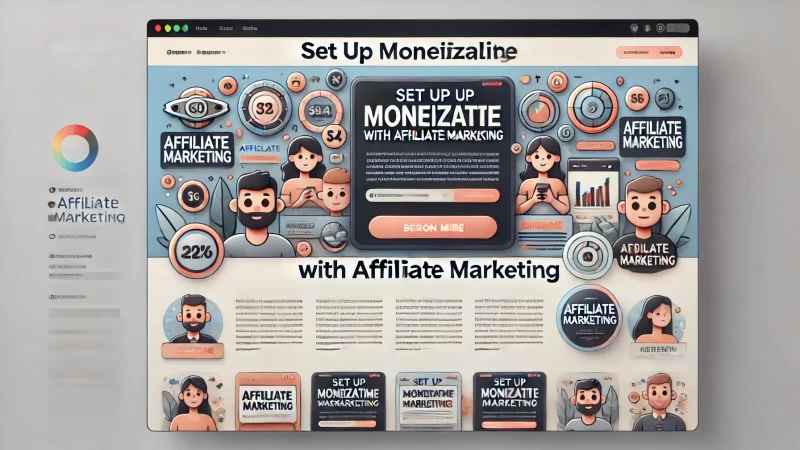
Affiliate marketing is one of the simplest ways to monetize your make money website. It allows you to earn commissions by promoting other companies’ products or services. I believe affiliate marketing is ideal for beginners because you don’t need to create your own products—just find high-quality items that your audience will love.
Once you join an affiliate program, you’ll get unique links to share. I suggest adding these links to your blog posts, email campaigns, or social media. Each time someone clicks your link and makes a purchase, you earn a commission. It’s a straightforward way to start making money while delivering value to your audience.
The Basics Of Affiliate Marketing For Beginners
Affiliate marketing revolves around promoting products and earning a commission when someone buys through your link. I always recommend focusing on products that are relevant to your niche and valuable to your audience. This approach builds trust, making readers more likely to click and buy.
I suggest signing up for affiliate programs that offer competitive commission rates. Some programs pay a percentage of each sale, while others offer flat fees per conversion. I’ve found that combining both types can boost your income significantly over time.
Choosing high-quality products is essential. I suggest testing or researching each product you promote to ensure it meets your audience’s needs. When your readers trust your recommendations, they’re more likely to follow your links and make purchases.
Affiliate marketing success often comes from being transparent with your audience. I advise clearly stating that you may earn commissions from your links. This not only builds trust but also complies with affiliate disclosure rules, ensuring your website remains compliant with legal requirements.
Lastly, focus on building relationships with your audience. I believe your readers are more likely to buy from you if they feel connected. Share your personal experiences with the products you recommend, and always prioritize your audience’s needs over making a quick sale.
How To Find Profitable Affiliate Programs In Your Niche
To find profitable affiliate programs, I recommend starting with a simple Google search, using keywords related to your niche followed by “affiliate program.” I often use affiliate networks like ShareASale or CJ Affiliate to discover reputable programs that fit within my niche.
I suggest considering the program’s commission structure. Programs that offer recurring commissions, such as for subscription-based services, can provide ongoing income. I think these types of programs are perfect for maximizing long-term revenue from a single customer.
Look for programs with good conversion rates. Some affiliate programs have higher sales conversion rates because their products are more in demand or priced appropriately for your audience. I suggest comparing different programs to see which ones convert best.
It’s important to choose programs with reliable tracking systems. I always ensure that the program uses accurate tracking to credit you for every sale. This avoids losing potential earnings due to technical issues or poor tracking mechanisms.
Lastly, I advise joining programs that offer useful resources. Many affiliate programs provide promotional materials like banners, product images, and email templates. These resources can help you integrate affiliate products smoothly into your website, saving you time while boosting earnings.
Adding Affiliate Links Strategically For Maximum Profit
Placing your affiliate links in the right spots can make a huge difference in your earnings. I recommend integrating them naturally into your blog posts or guides, ensuring that they fit the flow of the content. Avoid spamming links, as this can overwhelm readers and reduce trust.
Focus on placing links within high-traffic posts. I suggest identifying the pages on your site that get the most views using Google Analytics. Adding affiliate links to these posts can drive more clicks and sales, as they’re already popular with your audience.
Call-to-action buttons are another great way to get clicks. I find that using clear, actionable language like “Check Price” or “Get Yours Now” makes readers more likely to engage. Use bright, contrasting colors for your buttons to grab attention without being overly aggressive.
Don’t forget about email marketing. I believe that sending out affiliate links in your newsletters can increase conversions. Highlight the benefits of the products you’re promoting, and share personal stories to connect with your readers on a deeper level, motivating them to click.
Lastly, I suggest reviewing your affiliate links regularly. Programs and products change over time, so it’s important to update links that may no longer be relevant or profitable. Keeping your content fresh will ensure you maximize affiliate revenue and maintain reader trust.
Day 6: Monetize Your Website Through Ad Displaying
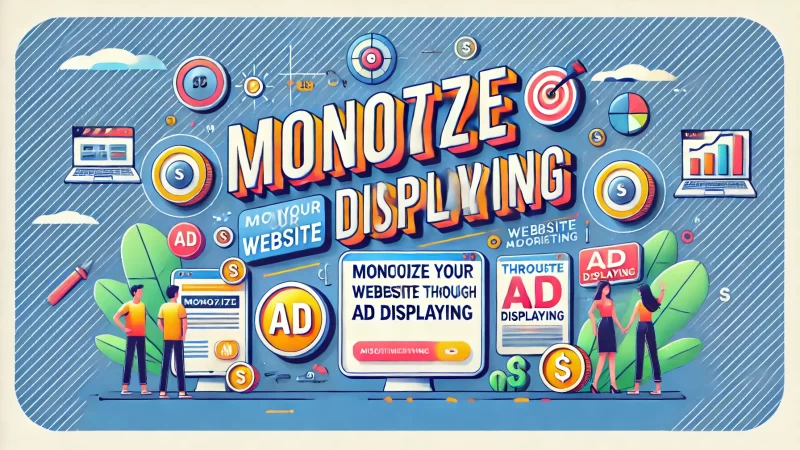
Displaying ads is another popular way to monetize your make money website. With this method, you earn money each time someone views or clicks on ads displayed on your site. I think ad networks like Monetag are great for beginners because they handle the placement and optimization for you, making it a hassle-free way to earn income.
While ads are easy to set up, I advise balancing them with user experience. Too many ads can clutter your website and frustrate visitors, which can negatively impact your traffic. The key is finding the sweet spot between monetization and a clean, user-friendly design.
How To Use Google AdSense To Earn From Website Traffic
Google AdSense is one of the most popular ad networks because of its simplicity. I recommend applying for AdSense once your website has consistent traffic and high-quality content. AdSense automatically displays relevant ads to your audience, making it easy to start earning right away.
To get approved, I suggest ensuring your site follows AdSense’s guidelines. This includes having sufficient content, a professional design, and pages like a privacy policy. I’ve seen websites get rejected for minor issues, so it’s worth double-checking everything before applying.
AdSense works on a pay-per-click (PPC) and cost-per-thousand-impressions (CPM) model. I love that it allows you to earn money just by showing ads, even if users don’t click them. However, I’ve noticed that your earnings will largely depend on your traffic volume and the type of ads displayed.
Once you’re approved, I advise experimenting with ad placement. Google AdSense provides automatic ad placement, but I think manually positioning ads can yield better results. Test different spots, like in-article ads or sidebar banners, to see where they perform best.
Lastly, it’s important to keep track of your earnings and analytics within the AdSense dashboard. I recommend using this data to adjust your strategy, focusing on placements and content that drive the most ad revenue. This constant optimization will increase your earnings over time.
Optimizing Ad Placement For Maximum Earnings
Ad placement plays a huge role in how much you can earn from displaying ads. I’ve found that ads placed near the top of the page, above the fold, generally perform better. Visitors are more likely to see and engage with ads that appear without scrolling, increasing your earnings.
I also recommend testing in-content ads. These ads blend seamlessly with your articles, making them less intrusive while still driving engagement. I’ve noticed that they often outperform traditional banner ads because they feel more organic to users, leading to more clicks.
Consider the mobile experience, too. Mobile traffic is growing, and I believe optimizing your ads for mobile users is crucial. Responsive ads that adapt to screen sizes will improve the user experience and ensure that you’re not losing out on mobile ad revenue.
Don’t overdo it. While it may be tempting to load your site with ads, I recommend a minimalist approach. Too many ads can slow down your site, hurt SEO, and frustrate users. I find that a clean design with strategically placed ads leads to higher earnings and better overall user engagement.
Lastly, analyze your ad performance regularly. I suggest using A/B testing to see which placements drive the most clicks and impressions. By continuously optimizing your ad strategy, you can maximize your revenue without compromising the user experience.
Alternatives To AdSense For Website Monetization
While AdSense is a great option, there are several alternatives that may offer higher payouts or better ad formats for your niche. I recommend trying networks like Adsterra, or Ezoic, which offers advanced optimization tools to boost earnings.
Another alternative I’ve explored is affiliate marketing ads. Unlike traditional ads, affiliate ads allow you to earn higher commissions based on conversions rather than clicks or views. If your audience is highly engaged, I believe this can be a more profitable option than CPC or CPM ads.
Native advertising platforms like Taboola or Outbrain are also worth considering. These ads blend into your content, making them less intrusive. I’ve noticed they can drive high engagement, especially when they’re targeted well. Native ads often outperform traditional display ads in terms of click-through rates.
In addition, you could explore selling direct ad space. I’ve heard of many successful websites partnering with businesses to sell banner space directly. This approach requires more effort, but I think it can lead to higher payouts, especially if your website has a niche, engaged audience.
Finally, I suggest experimenting with video ads. Platforms like YouTube or even self-hosted video ads can provide additional income streams. If your make money website includes video content, integrating video ads could help you earn more by capitalizing on this growing trend in online advertising.
Day 7: Boost Income With Email Marketing And Digital Products
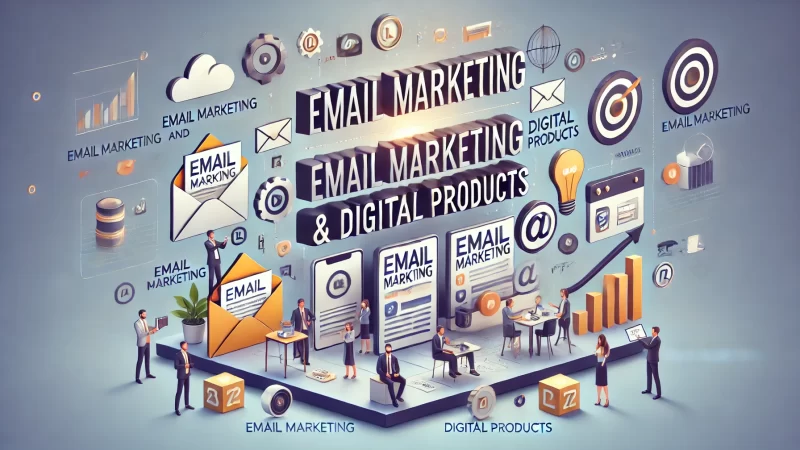
Email marketing and digital products are two powerful tools for increasing your make money website income. Building an email list allows you to connect directly with your audience and promote relevant products or services. I recommend starting your email marketing efforts early to build trust and provide value before introducing any paid offers.
Alongside email marketing, selling digital products like e-books or courses offers a scalable way to generate revenue. I think digital products are ideal because, once created, they can be sold repeatedly without additional production costs. This combination creates a sustainable income stream for your website.
Building Your Email List From Day One
I always advise starting your email list as soon as your website launches. This ensures you can build a direct line of communication with your audience from the beginning. I’ve noticed that offering a free resource, like a guide or checklist, in exchange for an email address can encourage more sign-ups.
Focus on creating valuable content that resonates with your target audience. When visitors feel like they’re gaining something meaningful, they’re more likely to join your list. I suggest using pop-up forms, embedded opt-ins, or exit-intent forms to capture email addresses without being overly intrusive.
I think consistency is key when it comes to email marketing. Once you have subscribers, keep them engaged with regular emails. Share useful tips, exclusive insights, or personal stories that align with your niche. Engaging content keeps readers interested and opens the door to future product promotions.
Segmenting your list is another tactic I recommend. By dividing your subscribers based on their interests or behavior, you can send targeted emails that feel more personal. I’ve found that segmented emails tend to get higher open and click-through rates, which means more opportunities for revenue.
Lastly, nurture your list over time. Don’t push sales right away. I believe building a relationship through helpful content first is essential. Once trust is established, your audience will be more receptive when you eventually introduce paid products or affiliate offers.
Crafting High-Converting Emails To Generate Sales
Crafting high-converting emails takes strategy. I recommend starting with a compelling subject line that piques curiosity without being too salesy. Subject lines are the first thing your subscribers see, so they must stand out. I’ve found that using power words like “exclusive” or “essential” can encourage more opens.
Once the email is opened, focus on delivering value right away. I suggest making your message clear and concise, with a strong call to action that guides your reader toward making a purchase. The more direct you are, the better the chances of conversion.
Storytelling can also increase conversions. Share your personal experiences or customer success stories to connect with your readers emotionally. I find that when people can relate to a story, they’re more likely to engage with the content and follow through with purchases.
Keep your design clean and mobile-friendly. Most people check emails on their phones, so I suggest testing how your emails look on different devices. Make sure your call-to-action buttons are easy to click and that the layout encourages scrolling through the entire message.
Finally, I advise tracking the performance of your email campaigns. Use analytics to measure open rates, click-through rates, and conversions. This data will help you refine your approach, focusing on the types of content and offers that resonate most with your audience.
How To Create And Sell Digital Products Like E-books Or Courses
Creating digital products is one of the best ways to monetize your expertise. I recommend starting with something you’re passionate about and knowledgeable in. For example, an e-book or online course that solves a common problem in your niche is more likely to succeed.
To get started, outline the content of your e-book or course. I’ve found that breaking it down into smaller, actionable sections makes it easier to create and more valuable for your audience. Organize your ideas in a way that flows logically, guiding your reader from start to finish.
I suggest using tools like Canva or Google Docs to design your e-book, or platforms like Teachable or Thinkific for courses. These platforms make it easy to produce professional-looking products without needing technical expertise. Once your product is ready, promote it through your email list and blog.
Pricing is important. I recommend offering a lower-priced product initially to attract buyers, then upselling them with more premium content later. I believe this strategy helps build trust and encourages repeat customers, allowing you to gradually increase your revenue.
Don’t forget to include testimonials or case studies. I advise showcasing feedback from people who’ve benefited from your products to build credibility. Positive reviews and success stories can convince hesitant buyers to take the plunge and purchase your e-book or course.
Best Practices For SEO To Drive Long-Term Traffic
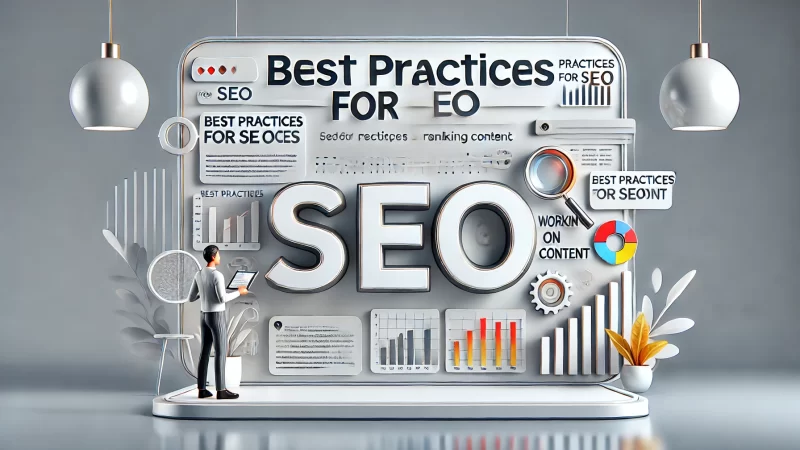
Driving traffic to your make money website through search engine optimization (SEO) is crucial for long-term success. I recommend focusing on both on-page and off-page SEO strategies to increase your website’s visibility. SEO can take time, but once your site starts ranking higher, you’ll benefit from consistent organic traffic without relying heavily on paid ads.
Good SEO practices involve optimizing your content, site structure, and backlinks. I suggest building a solid foundation by ensuring your website is fast, mobile-friendly, and easy to navigate. Improving user experience will also positively impact your rankings and lead to more traffic.
How To Optimize Your Website For Search Engines
Optimizing your website for search engines starts with on-page SEO. I suggest using your primary keyword naturally in key areas like the title, meta description, headings, and URL. However, I advise against overusing it, as search engines prioritize user experience over keyword stuffing.
I believe site speed plays a significant role in SEO. A slow website drives visitors away, which can hurt your rankings. I recommend optimizing your images, enabling browser caching, and using a content delivery network (CDN) to boost your site’s loading speed.
Mobile optimization is essential. Since more people browse on mobile devices, I suggest using a responsive design that adjusts seamlessly across different screen sizes. A mobile-friendly site not only improves SEO but also enhances the user experience, which leads to higher engagement.
Don’t overlook internal linking. I think linking to other relevant content within your site helps search engines understand your content structure. It also keeps visitors engaged by directing them to other valuable resources, which can reduce bounce rates and improve time spent on your site.
Lastly, I recommend creating a sitemap and submitting it to Google Search Console. This helps search engines crawl your website more efficiently, ensuring all your pages are indexed. An updated sitemap improves visibility and ensures your most important content gets discovered.
Using Keywords To Rank Higher On Google
Keyword research is the foundation of any successful SEO strategy. I suggest using tools like Google Keyword Planner or SEOPowersuite to identify high-volume keywords that align with your niche. I’ve noticed that long-tail keywords, which are more specific, often have less competition and lead to quicker ranking improvements.
Place keywords strategically throughout your content. I recommend including them in titles, subheadings, and the first 100 words of your blog post. However, I advise focusing on readability first—don’t force keywords in where they don’t make sense. Google rewards content that reads naturally.
Avoid keyword cannibalization. I’ve found that targeting the same keyword across multiple pages can confuse search engines, leading to lower rankings for both. I suggest creating unique content for each target keyword to avoid this issue and maximize your site’s SEO potential.
Utilize latent semantic indexing (LSI) keywords. These are related terms that help Google understand the context of your content. I believe using LSI keywords naturally within your text enhances your SEO without resorting to repetitive keyword stuffing.
Lastly, optimize your meta descriptions. While these don’t directly impact rankings, I’ve found that well-crafted descriptions improve click-through rates. A higher click-through rate signals to Google that your content is valuable, which can help your page rank higher in search results.
How Backlinks Can Increase Your Website’s Authority
Backlinks are one of the strongest indicators of a website’s authority. I recommend focusing on quality over quantity. A single backlink from a high-authority site, like a major publication or an industry leader, is far more valuable than dozens from low-quality sources.
I suggest reaching out to other website owners in your niche for guest posting opportunities. By contributing valuable content to their blogs, you can earn backlinks while also driving traffic to your site. I’ve found that this is one of the most effective ways to build backlinks and grow your audience.
Broken link building is another tactic I recommend. I often look for broken links on other websites in my niche and offer my own content as a replacement. This helps both parties: the website owner fixes their broken link, and I earn a valuable backlink in return.
Content that naturally attracts links is critical. I advise creating high-quality, shareable resources like in-depth guides, infographics, or research reports. When others find your content valuable, they’re more likely to link to it, boosting your site’s authority and search rankings.
Lastly, monitor your backlink profile regularly. I suggest using tools like Ahrefs or Moz to track where your backlinks are coming from. Disavowing harmful or spammy links can prevent your website from being penalized by search engines and protect your rankings.
Analyzing Website Performance To Maximize Earnings
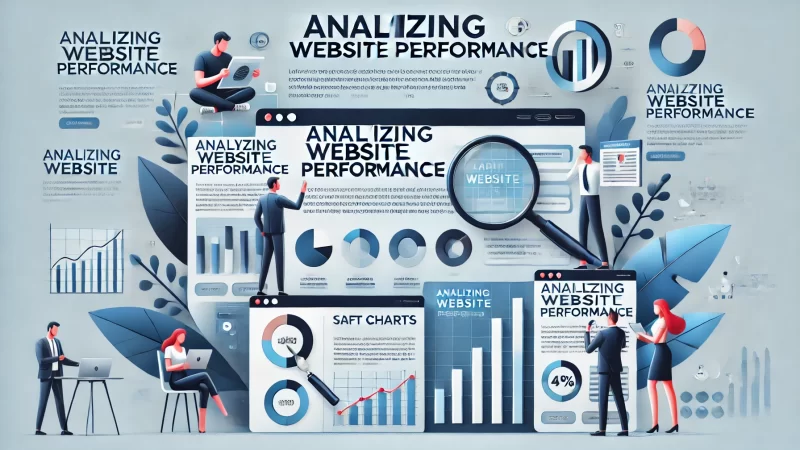
To maximize your earnings from your make money website, it’s crucial to continuously analyze performance. I believe understanding your website’s analytics allows you to see what’s working and what needs improvement. By identifying key metrics, you can refine your content and monetization strategies to boost income.
Regular analysis helps you spot trends and optimize your site for higher conversions. I advise using tools like Kissmetrics to track visitor behavior, engagement, and revenue. Monitoring these metrics consistently will give you insights into how your audience interacts with your site, helping you make data-driven decisions.
Understanding Website Analytics And Key Metrics
Website analytics provide a wealth of information that can shape your growth strategy. I recommend focusing on metrics such as total visitors, page views, and session duration to gauge your site’s overall health. These metrics show how many people are visiting and how long they stay, which impacts your monetization potential.
Another critical metric I advise tracking is the bounce rate. A high bounce rate indicates visitors leave without exploring further, which may mean your content isn’t engaging or your site loads too slowly. I find that reducing bounce rates can significantly improve conversions and boost earnings.
Pay attention to your audience demographics. I’ve noticed that understanding your audience’s location, interests, and device preferences helps tailor content and ad placements for better results. I advise creating targeted content based on these insights to improve engagement and increase click-through rates.
Referral sources matter too. Knowing where your traffic is coming from—whether through search engines, social media, or direct visits—helps you allocate resources more effectively. I’ve found that focusing on your most profitable channels maximizes traffic and revenue.
Lastly, track the revenue per visitor. I always emphasize this metric, as it directly correlates with your website’s profitability. By optimizing content and ads for higher conversions, you can increase the amount each visitor contributes to your income, enhancing your overall earnings.
Tracking Traffic, Bounce Rates, And Conversion Rates
Traffic is the lifeblood of any website, and I suggest paying close attention to both the quantity and quality of visitors. While increasing traffic is important, I believe focusing on targeted traffic—visitors genuinely interested in your content or products—leads to higher conversions and more sustainable income.
Bounce rates can signal issues with content relevance or site design. If visitors leave quickly, I recommend reviewing the pages with high bounce rates and improving the user experience. Slower load times or irrelevant content can drive visitors away, reducing your ability to generate income.
Conversion rates are another essential metric to track. I find that testing different calls to action, ad placements, or affiliate links can improve conversion rates significantly. Even small tweaks, like changing a button color or adjusting copy, can have a noticeable impact on how many visitors take action.
Engagement metrics, such as average session duration and pages per session, tell you how well your content holds the audience’s attention. I advise aiming for longer session durations, as engaged users are more likely to click on ads, affiliate links, or sign up for email offers, increasing your income opportunities.
Tracking returning visitors versus new visitors is also key. I find that loyal readers are more valuable because they’re more likely to convert. I recommend offering them special content or promotions to keep them coming back and boosting your site’s long-term profitability.
Adjusting Your Strategy For Continued Growth
Analyzing data regularly allows you to adjust your strategy for better results. If traffic sources shift or bounce rates increase, I suggest reevaluating your content and SEO efforts. Keeping an eye on these changes ensures you stay ahead and continuously optimize for more income.
Split testing is a powerful tool for refining your website. I recommend experimenting with different page layouts, headlines, or affiliate products to see which versions generate more clicks or sales. I’ve learned that testing small changes can lead to big improvements in both traffic and revenue.
Keep refining your monetization strategies. If ad revenue drops, I advise exploring new affiliate programs or creating additional digital products. Diversifying income streams ensures your earnings remain stable, even if one method underperforms.
Regularly review your content’s performance. I suggest updating or repurposing high-traffic articles to keep them fresh and relevant. This boosts your SEO and keeps visitors engaged, ultimately leading to more clicks, conversions, and income.
Lastly, stay informed about industry trends. I believe adapting to new technologies, algorithms, or user behaviors is critical for long-term growth. Continuously learning and evolving helps you stay competitive, ensuring your make money website remains profitable.
Final Thoughts: Why Persistence Is Key To Success
Success with a make money website doesn’t happen overnight. I’ve found that persistence and consistency are key to achieving long-term results. Building traffic, optimizing monetization strategies, and growing your income takes time, but staying focused on your goals will ultimately lead to success.
I suggest not getting discouraged if progress seems slow at first. It’s normal for websites to take a few months to gain traction. I believe the real rewards come from continuously learning, refining your approach, and staying committed to improving your site and its offerings.
Keeping Consistency To See Results
Consistency is the foundation of a successful website. I advise sticking to a regular content schedule, whether that’s posting once a week or more frequently. Readers and search engines value fresh, high-quality content, and I’ve noticed that consistent updates lead to better rankings and more traffic.
Email marketing and engagement efforts should also be consistent. I recommend sending out regular newsletters or offers to keep your audience engaged. When readers see value in your emails, they’re more likely to trust your recommendations and act on them, which drives conversions and income.
I also suggest consistently monitoring your site’s performance. Analytics provide insights into what’s working and what needs adjustment. By regularly reviewing your data, you can make small tweaks to improve traffic flow and conversions over time, resulting in steady growth.
Stick with your SEO strategy. I believe SEO takes time to show results, but with consistent optimization, you’ll eventually rank higher and gain more organic traffic. It’s tempting to switch tactics quickly, but I find that persistence with SEO always pays off in the long run.
Finally, consistency builds credibility. I’ve found that when you consistently provide value, your audience begins to trust you. This trust is essential for long-term success, as loyal readers are more likely to purchase from you, click on your affiliate links, or share your content with others.
Tweaking And Improving As You Grow
Growth requires regular adjustments. I suggest always looking for ways to improve your site, whether through new monetization strategies, content updates, or user experience improvements. Small, consistent changes can lead to major increases in traffic and income over time.
I recommend reviewing your affiliate programs and partnerships regularly. Some may stop being relevant or profitable, and it’s important to replace them with better offers. I’ve found that this flexibility ensures you always offer the best value to your audience while maximizing revenue.
Listen to your audience’s feedback. I believe their insights can help you identify content gaps or improvements to your website. Engaging with your readers and making the changes they suggest builds trust and keeps them coming back for more.
Don’t be afraid to innovate. I’ve seen websites grow exponentially by trying new formats like podcasts, webinars, or video content. I recommend staying open to new ideas that could engage your audience differently, helping your site grow and diversify its income streams.
Lastly, always set new goals. As your website grows, I suggest adjusting your targets to reflect your progress. Whether you aim for higher traffic numbers, better conversion rates, or more income, setting new milestones keeps you motivated and focused on continued growth.
Frequently Asked Questions (FAQ)
How long does it take to see profits from a make money website?
It can take anywhere from a few months to over a year to see significant profits from a make money website. I suggest focusing on building quality content and traffic first. As your audience grows, monetization strategies like affiliate marketing, ads, and digital products will start generating income.
Which is better for monetization: affiliate marketing or ads?
Both affiliate marketing and ads can be profitable, but I believe affiliate marketing typically offers higher returns, especially if you promote products aligned with your audience’s interests. Ads are great for generating passive income with high traffic, but affiliate marketing can provide larger commissions for targeted conversions.
How much traffic do I need to start making money from my website?
There’s no fixed amount of traffic needed, but I recommend aiming for consistent daily visitors before monetizing. Even with a small audience, a focused niche and high engagement can drive affiliate sales or digital product purchases. For ad revenue, having a few thousand visitors per month is a good starting point.
How do I choose the right niche for my make money website?
I advise picking a niche that aligns with both your interests and market demand. Look for topics with consistent audience interest and the potential for multiple income streams, such as affiliate programs, digital products, or advertising opportunities. A niche you enjoy will keep you motivated long-term while ensuring profitability.
What are the best tools for tracking website performance?
I recommend using Google Analytics as your primary tool for tracking website performance. It provides valuable insights into visitor behavior, traffic sources, and conversions. Other tools like Google Search Console help track SEO performance, while platforms like Ahrefs and SEMrush are excellent for keyword and backlink analysis.
How can I improve my SEO to rank higher on Google?
To improve your SEO, I suggest optimizing your content with relevant keywords, improving site speed, and ensuring your website is mobile-friendly. Additionally, building backlinks from authoritative sites and regularly updating content with fresh, valuable information will help improve your rankings and attract more traffic.


